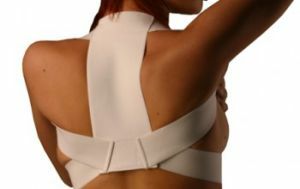 Ankle joint is most often subjected to mechanical traumatic effects, and loses stability much earlier than other joints of our body.
Ankle joint is most often subjected to mechanical traumatic effects, and loses stability much earlier than other joints of our body.
This is due to the huge load on this area of the limb, which withstands the entire body weight. To immobilize the ankle and prevent further deformation of the joint in case of trauma or disease, prosthetic and orthopedic products - orthoses, bandages and tutors - are used.
Contents of the article
- Devices for immobilization
- Features and structure of the orthosis
- Design of the tread
- Characteristics of the bandage
- Indications for use
- Application for fracture
- Types of retainers
- How to choose?
- Product application and care features
- Our TOP-7 best products
- Customer's opinion
Devices for immobilization
Depending on the degree of damage to the musculoskeletal system, various types of orthopedic products can be used.
There are more than 650 items in total.
For the immobilization of joints, in particular the ankle, the following devices are used:
- Orthesis .This is an orthopedic device, the purpose of which is to restore the motor, support and locomotor function of the entire body or its limbs. Orthoses preserve the ability to exercise motor function.
- The bandage is an elastic band or bandage. The purpose of use can be both preventive and curative measures.
- The tread is a device whose purpose is complete immobilization of the limb. They are designed to immobilize and fix the damaged area in a certain position.
Each of the above fixers has a different device, scope and is made of different materials.
Features and structure of the orthosis
The ankle brace is a metal frame made of tires that is worn on the lower limb. In a place where the  is an ankle, the tires are connected with special hinges.
is an ankle, the tires are connected with special hinges.
To ensure that the carcass is sufficiently rigid, the tires are fastened to each other by means of semirings. To ergonomically cover the limb, the tires and semirings are equipped with special sleeves( leather, plastic or polymeric).
There are lock and lock orthoses. The purpose of the lock is to make the hinges perform movements.
The patient can activate the lock manually or choose an orthopedic device with automatic hinges.
Tractor design
The tutor is used to immobilize the ankle, it looks like an orthosis, it is also made in the form of sleeves, has straps or lacing, only in its structure there are no moving hinges.
The material for the manufacture of tutors is: hard metal, polymers, leather, plastic. If you want to use a leather tutor, then the casings are equipped with a metal frame using semirings and tires. This gives it extra rigidity.
There are fixing tutors that are used to fix the limb at a specific time, for example, at night. And dynamic, used during active movements.
Characteristics of the bandage
 The fabric used to make the bandage is usually fabric, in order to maintain elasticity. Use linen, silk, cotton, semi-silk fabrics.
The fabric used to make the bandage is usually fabric, in order to maintain elasticity. Use linen, silk, cotton, semi-silk fabrics.
Bandages that can be purchased at a pharmacy or clinic are called massages. There are times when you need a bandage with individual characteristics, then it is made to order. The bandage can be different, depending on what the activities are aimed at: the prevention or treatment of an ankle joint disease.
It creates optimal moisture and air exchange, carries out compression of soft tissues, has a supporting, micromassage property.
Indications for use
Depending on the problem and its severity, the specialists prescribe to the patient this or that kind of fixing devices. In what cases is it expedient to use this or that immobilizing device?
Tutors and orthoses have been used in modern medicine recently, for many years therapeutic measures in the ankle area have been in bandaging and the use of plaster casts.
New prosthetic and orthopedic products have a more reliable fixation, and the open area of the ankle joint simplifies access for the purpose of medical treatment.
The right orthosis can only be selected by a specialist. In each case, the product is selected individually, starting with the shape and placement of the hinges and ending with the material of the fixing sleeves. Ankle brace is used in the following cases:
- with partial, complete or microfractures of ligaments and tendons;
- of degenerative, dystrophic, inflammatory conditions;
- dislocations and subluxations of the lower leg;
- of various extraarticular pathologies;
- during the recovery period after operations and ankle injury;
- in case of rickets in children;
- for ankle dysplasia;
- cerebral palsy;
- with stop paralysis;
- for the prevention of injuries in heavy physical work and workloads.
You can only prescribe wearing a tutor and find the best option in a particular situation only by a doctor.
The tractor can be used to solve a variety of problems. Most often it is recommended for:
- presence of paralysis of the lower extremities;

- for hip and ankle fractures during recovery;
- abnormalities, when one leg is shorter than the other;
- of varus and valgus deformities of the foot;
- spinal cord injuries;
- cerebral palsy;
- trauma and after operations on the lower leg;
- deforming arthrosis of the shin.
Ankle bandage is used for:
- prophylaxis during extreme physical exertion, when doing sports, when it is necessary to increase the load on the legs;
- treatment of existing fractures, bruises and ligament ruptures in the ankle region;
- effective maintenance of tonus at the final stages of treatment after fractures, cracks, discrepancies of interosseous syndesmosis;
- eliminating the existing pain in the muscles after the load;
- elimination of postoperative scars in the calf area.
Application for fracture of the
Fracture of the ankle is often enough, the diagnosis in this case should be immediate, since sometimes a fracture is confused with a dislocation and an incorrect treatment is prescribed.
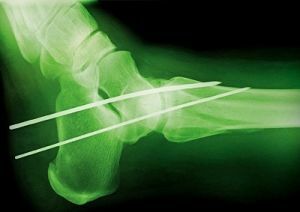 The quality of treatment and the speed of the healing process depend on timely care. You can break an ankle during a fall on your straightened legs or in case of an accident.
The quality of treatment and the speed of the healing process depend on timely care. You can break an ankle during a fall on your straightened legs or in case of an accident.
If an ankle is displaced or crushed, doctors use surgery. After setting the bones of the ankle joint in a normal position, tutors are used, completely limiting the mobility of the limb.
Orthosis can also be recommended, but more often at the final stages of treatment.
To support the proper functioning of the ankle and prevent damage, it is recommended to use a bandage.
Types of fixators
Given the severity of injury or illness, the doctor prescribes the use of orthopedic fixatives, which will most effectively cope with the task. According to the degree of rigidity, they are divided into three types:
- Soft .These are special bandages that have elastic fibers in the fabric. Such bandages are used in the diagnosis of injuries or strains of mild or moderate severity. These dressings relieve a painful symptom, prevent edema, have a compression and massage properties.
- Hard .Such orthopedic adaptations are distinguished by the presence of firm frame inserts, which help immobilize the limb. The product has belts and ties, they tightly fix the joint with the shin area and the foot. Hard fixatives are recommended for fractures, serious dislocations, after surgery.
- Semi-rigid .This type of lock has elastic straps and cords, which are designed to serve as an elastic bandage. To give the product rigidity, the retainer is provided with metal or plastic inserts in the form of plates. Semi-rigid products are shown for certain diseases and functional disorders of the ankle.
Devices have differences in purpose:
- Functional .Designed for permanent wearing, they help ensure maximum movement with irreversible changes in the joint.
- Treatment and rehabilitation .They are used to get rid of a disease or injury, as well as during rehabilitation.
- Preventative .Called to protect the limb from damage and external influences.
How to choose?
Before buying this or that fixative, you should consult a traumatologist. It is the doctor who will tell you what kind of product is needed in your particular case.
Conclusion he will do based on the severity of injury, anatomical features, the presence of allergies to the material, concomitant diseases, etc.
The individual selection of the product is based on selection according to the size of the foot, sometimes measurements of the shin circumference are required so that the fasteners do not rub. If you select a device to be a doctor, he will make all the necessary measurements right in the office.
Application of the product and care features of
The patient can attach the retainer himself( if this is not a modular unit product).Before installation, you need to perform hygienic procedures: 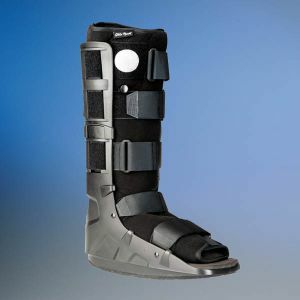
- a little massage the ankle, before that you can take a bath;
- put on a sock without seams from cotton fabric( this does not apply to elastic bandages).
With a mild degree of disease, it is possible to put on the fixator standing, the average severity implies putting on in the sitting position and only after that it is necessary to get up. If it is a serious illness, you need to put the fixator sitting, but get up and walk only with support.
Most orthopedic attachments are sold with operation advice. By following the following simple rules, the service life of the product can be maximized:
- Cleaning of braces and tutors, as well as the washing of the bandage should be carried out without the use of chemical agents .The best option - laundry soap.
- It is forbidden to use the washing machine .The product is only cleaned by hand.
- Drying in suspended condition is not recommended .The retainer must dry lying on a horizontal surface.
Our TOP-7 of the best products of
We researched the market and picked up the seven best devices for the immobilization of the ankle:
- Orthosis immobilizing hinge Otto Bock 50S15 with the ability to adjust the angle of flexion / extension of the ankle, immobilizes the joint and the foot. It is used for damage to tendons, ligaments, soft tissues, fractures, rehabilitation and after operations.
- Ankle brace Orlett HAS-301 is designed for the stabilization, unloading of the ankle, equipped with a volume controller
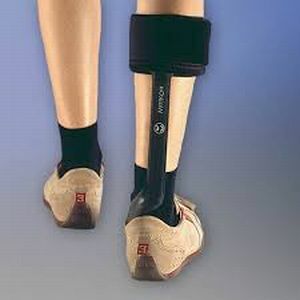 movements. With its help, you can completely immobilize the limb or enable the flexion / extension mode. Pillow-pillows minimize shock loads, absorb. Used for paralysis, ankle injuries, intra-articular fractures, after surgery and during rehabilitation.
movements. With its help, you can completely immobilize the limb or enable the flexion / extension mode. Pillow-pillows minimize shock loads, absorb. Used for paralysis, ankle injuries, intra-articular fractures, after surgery and during rehabilitation. - Hard hinged sports brace Rehband 7772 .The main materials are plastic and polyester. The product provides lateral stability, has a warming, compression effect. It is used for sports injuries, for rehabilitation and for prevention.
- Turbine Orlett LAB 201 is made of cotton fabric, equipped with four metal ribs of rigidity, fixed on the ankle joint lacing. The product can completely replace the gypsum dressing. Used for fractures and injuries, when complete immobility is needed.
- The Tread The Extempo is designed for walking, easy to fit into regular shoes. Made of leather, fastened with straps. Effective with injuries, instability of the ankle, cerebral palsy.
- Elastic Compression Bandage Orlett MAN-101 is made from a cotton and polyester fiber substitute, recommended for light bruises and ankle sprains.
- Banding Rehband 7761 reinforced with straps, sporty. It is used in functional therapy and sports medicine.
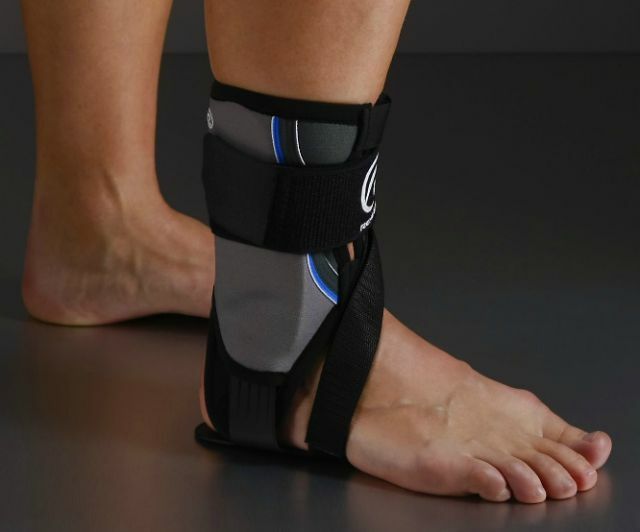
On the picture orthosis Rehband 7772 for mounting on the ankle joint
Small video-selection on the theme:
Buy ankle bandages, orthoses and tutors for a price from 1500 to 4000 rubles, it all depends on the complexity of the structure, material and manufacturer. Individual orthosis costs more - about 10,000 rubles.
Opinion of consumers
Two years ago I received an athlete's ankle injury. Treatment was carried out with the help of a rigid orthosis. Now, having a bad experience, I always use a bandage in training.
Andrew, 38 years old
After a serious accident, I had to do an operation on my shins. The doctor recommended a tutor. This is much more convenient than gypsum. Recovery is effective, as long as it suits me.
Constantine, 43 years old


